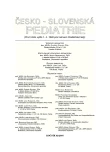-
Medical journals
- Career
Congenital Myasthenic Syndrome (CMS)
Authors: J. Hálek 1,2; M. Neklanová 1; P. Seeman 3
Authors‘ workplace: Dětská klinika Lékařské fakulty UP a Fakultní nemocnice, Olomouc přednosta prof. MUDr. V. Mihál, CSc. 1; Ústav lékařské biofyziky Lékařské fakulty UP, Olomouc přednosta prof. Ing. J. Hálek, CSc. 2; Centrum lékařské genetiky a reprodukční medicíny GENNET, Praha vedoucí MUDr. D. Stejskal 3
Published in: Čes-slov Pediat 2007; 62 (6): 393-397.
Category: Case Report
Overview
Congenital myasthenic syndromes (CMS) belong to diseases affected neuromuscular transmission. They are characterized by muscular weakness of the “myasthenic” type manifested in the early period of life. Their clinical manifestations are based on heterogeneous disorders of neuromuscular plate function in the presynaptic, synaptic and postsynaptic area. The disease may be rather frequently encountered in the European Gipsy population, where it is predominantly caused by homozygous mutation in the CHRNE gene (1267delG); it becomes manifest from the early age by oculomotoric disorders and ptosis, later by frequent and severe respiratory infections, mastication and swallowing disorders. A general muscular weakness at the early age is not a dominant sign.
The case report illustrates a typical course of the disease and summarizes the knowledge on the diagnostic and therapy.Key words:
congenital myasthenic syndromes, muscular weakness, neuromuscular connection
Labels
Neonatology Paediatrics General practitioner for children and adolescents
Article was published inCzech-Slovak Pediatrics

2007 Issue 6-
All articles in this issue
- Anemia, Nonspecific Intestinal Inflammations and Possible Diagnostics
- Hyperkinetic Disorder at the Child Age
- Different Manifestations of the Fragile X Chromosome Syndrome and Their Causes
- Childhood Injury in Four Czech Regions
- Long-term Results of Gastric Transposition in Children
- Is There a Metabolic Syndrome in the Childhood?
- Nitrobenzene Poisoning of a 4.5-year Boy
- Congenital Myasthenic Syndrome (CMS)
- Czech-Slovak Pediatrics
- Journal archive
- Current issue
- Online only
- About the journal
Most read in this issue- Different Manifestations of the Fragile X Chromosome Syndrome and Their Causes
- Congenital Myasthenic Syndrome (CMS)
- Nitrobenzene Poisoning of a 4.5-year Boy
- Long-term Results of Gastric Transposition in Children
Login#ADS_BOTTOM_SCRIPTS#Forgotten passwordEnter the email address that you registered with. We will send you instructions on how to set a new password.
- Career

